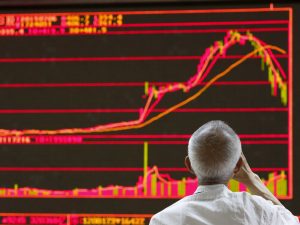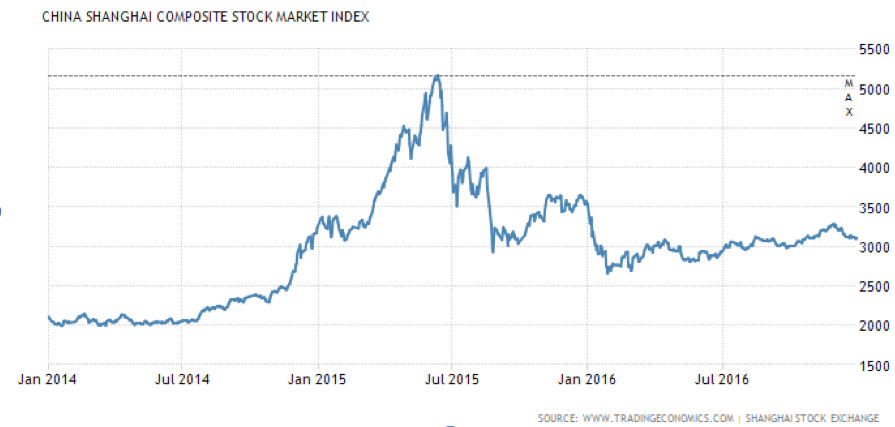Crash Interventions: Shanghai Stock Market Case
By Harley Comrie
On the 2nd of July 2015 in the middle of a crowded Shanghai shopping mall a woman jumped to her death. Her public suicide was reported by bloggers as a human consequence of the Shanghai stock market crash three weeks earlier. Photos of her fate were circulated through WeChat, a popular Chinese social media app. Days earlier in Shenyang another suicide had occurred under similar circumstances. Foreign media reported it too was motivated by the stock market crash.
The Chinese Communist Party (CCP) response to the Shanghai stock market crash and the causes of the crash itself serve as warnings that not liberalizing a market may ultimately damage an economy more than sustain it.
Shanghai Stock Market
In 1990 the CCP created the Shanghai stock market. In an effort to limit the effects of trade liberalization the Party divided the stock market into two, creating one market for Chinese citizens and another for international investors. This action isolated Chinese citizens from international capital flows and gave them the opportunity to fund and profit from their own market. This isolation was at times advantageous, for example during the 2008 Global Financial Crisis (GFC), when Chinese markets were shielded from the financial maelstrom. However, the ability of Chinese companies to raise capital was reduced, distorting the market and hurting competition.
The Shanghai stock market was promoted by the CCP as a pathway for middle-class Chinese to achieve self-enrichment through financialization, effectively replacing the welfare state. Government slogans such as “Dream a Chinese dream” encouraged investment. After a period of initial skepticism the Chinese middle class overwhelmingly invested in the market, resulting in a uniquely egalitarian market composition.
According to a CBC report in 2015, the Shanghai stock market is the most active stock market in the world, 85% of trades in the market are retail-based and 2/3rds of investors did not graduate from high school. Credit Suisse estimates that 80% of urban Chinese households are invested in the stock market, with around 30% of their cash invested in stocks.
Whilst US households own (directly and indirectly) close to 80% of their stock market, the distribution of stock ownership is highly concentrated in the top 10% of income earners. The egalitarian distribution of ownership in the Shanghai stock market is ethical and economically beneficial.
Record levels of middle class involvement, isolation from foreign markets, and supercharged government rhetoric elevated the Shanghai stock market as an extremely important government institution. Various leaders of the CCP routinely claimed responsibility for the successes of the market (not unlike the current US President, Donald Trump), thus setting themselves up to be blamed when the market crashed. An example of the supercharged rhetoric can be found in The People’s Daily Newspaper, a state-owned media company, which ran an article two months before the crash stating the Chinese bull market “had just begun”.
The Bubble
The Shanghai Composite Index grew more than 150% between June 2014 and June 2015. Chinese investors were purchasing stocks rapidly, pushed on by exaggerated predictions of future growth.
“The meltdown of the Chinese equity market in the summer of 2015”, a study by Chinese economists, Dehong Liu, Hongmei Gu, and Tiancai Xing found that “the bubble is primarily attributed to the investors mispricing on the equity risk premium. When investors overreact to positive government policies, they become more risk-loving, resulting in decrease of the equity risk premium and, consequently, creating the equity bubble.” In other words, overreactions to the CCP’s economic policies created the bubble.
- One Belt, One Road
The re-announcement of major Chinese fiscal policy One Belt, One Road on October 24, 2014 had an especially notable effect. This policy, introduced by President Xi Jinping, focuses on connectivity and cooperation between Eurasian countries and encompasses roughly 60 nations. The cumulative investment over time is estimated to be between US$4 – 8 trillion. Subsequent widespread positive coverage of the policy by state-operated media led to a huge surge in stock market investment. Negative media coverage of the announcement was extremely limited. The resulting one-sided coverage by the Chinese state-owned media fueled overreactions to this CCP policy and others like it.
The combination of government media control and government economic stimulation is responsible for the environment that spawned the speculative bubble.
Margin buying also fueled a significant portion of the speculative bubble. Margin buying is the practice of purchasing a stock, only paying for the margin and borrowing the balance. This process allows borrowers to take on additional risk, increasing market volatility. By the 27th of May 2015, 2.1 trillion Yuan of stocks on the Shanghai stock market had been purchased on margin.
Chinese investors understood that the CCP’s preference for state-owned companies had given these companies a market advantage. They did not have to be as competitive as private companies and it was unlikely the CCP would allow them to fail. This led to an over-valuation of state-owned company stocks by investors looking for safe investments.
CCP regulators made two attempts to slow stock market investment before they accepted the boom as legitimate. The China Securities Regulatory Commission (CSRC) raised collateral requirements for margin trades on December 8th 2014, which resulted in a 5.4% fall in stocks the following day. Then on January 8th 2015 China’s banking regulator cracked down on margin lending, which resulted in a 7.7% fall in stocks the following day. Despite these policy measures, both the CSRC and regulators failed to moderate the stock market.
That Popping Sound
The bubble popped on the 12th of June 2015. According to economic analysis by the European Parliament Policy Department, Chinese investors lost around EUR 5 trillion in the initial crash. Two major aftershocks followed on the 27th of July and the 24th of August. The Shanghai stock market eventually stabilized in January 2016. Approximately 2/5ths of the market’s value at the June 2015 high was lost.
Government Intervention in Stock Market
The CCP’s regulatory response to the crash included the following actions:
- Compulsory orders that brokers buy shares
- Prohibition on selling shares
- Suspension of initial public offerings
- Relaxation of regulations on insuring stock purchases
- A Chinese Central Bank pledge to loan 260 billion Yuan to major brokerage firms for stock purchasing
- Suspension or strict control of most companies on the stock market
- Liberalization of the RMB reference rate
- Installation of a circuit breaker system
Implications of Interventions
Stock markets have winners and losers. Winners are those who invest in the most productive companies. Productivity is rewarded in capitalism because it spurs economic growth. The ability of markets to allocate resources efficiently is commonly understood through Adam Smith’s invisible hand. This theory holds that the pursuit of self-interest will provide the most social good. The CCP’s regulatory action limited the freedom of companies and investors to react in self-interest to the crash. The resulting market distortion caused uncertainty and undermined market legitimacy. Markets without legitimacy generally do not attract investor capital, which damages the market and slows economic growth.
Capitalism holds that those who are most productive are most deserving of resources. Utilitarianism argues that whichever action generates the greatest good is the most moral action. Distributing resources to where they can be most efficiently used ensures maximum growth. To a capitalist, growth is good, thus the use of free markets to efficiently distribute resources is a utilitarian good. By distorting the market the Chinese government chooses who wins and who loses. Intervention erodes the utilitarian justification of capitalist markets.
Persisting capital flight from China may be a sign investors still are wary of CCP market policies. In December 2015 Chinese imports from Hong Kong soared more than 60% year on year, which can be attributed to fake invoice schemes moving cash offshore. Investors make these economic decisions despite the risk of being criminally prosecuted for money laundering. The stock market bubble was created by CCP policies and policies in response to the crash failed to free the market.
Regulatory measures by panicked governments can easily backfire. The circuit breaker system was a perfect example of misguided regulation. The system worked by halting trading for a certain amount of time if trades fell below a certain limit. The theory behind circuit breakers was that they would lessen market volatility by slowing the market. In reality, market volatility increased as investors only had a small time window to trade before the market was halted. Following this realization the CCP removed the circuit breaker system from the Shanghai stock market in January 2016.
Media & Investor Suppression
After the crash, Credit Suisse analyst Dong Tao claimed, “social stability is clearly at stake” due to the huge losses sustained by the middle-class. China expert and Professor of International Relations Mark Beeson stated, “The authority of the CCP, even its widespread political legitimacy, is almost entirely based on its ability to guarantee rising living standards and economic security.” Understanding the threat posed by its falling credibility, the CCP sought individuals to blame for the market crash.
Wang Xiaolu a journalist for Caijing (one of China’s leading business magazines) was broadcast on television throughout China “confessing” his responsibility for triggering the stock market crash. The idea that a journalist could be responsible for a stock market crash has little factual basis. The arrest of Wang Xiaolu was a transparent attempt to create a narrative shifting responsibility away from the government.
In addition, according to a leaked party directive shortly afterwards on the 23rd of June, the government ordered the media to dramatically reduce stock market reporting and present only unbiased, rational information regarding the market. The days of encouraging state-owned media to create a mythical Chinese bull market had abruptly ended.
On the 7th of October 2015, the government introduced Announcement 18. This was a new law threatening ‘severe punishment’ for any major managers or shareholders selling shares of listed companies for a period of six months. The regulation froze trillions of Yuan in privately owned assets. Announcement 18 marked a shift from scapegoating investors instead of journalists. High profile arrests against investors were made, such as the arrest of highly successful investor Xu Xiang for insider trading on the 22nd of November.
Mercantilism is not the Way Forward
When Adam Smith conceptualized the invisible hand distributing resources to those who were most productive he lived in an era of mercantilism. Mercantilism is an economic system where government regulation of the economy is designed to promote nationalistic ends. China engaged in mercantilism through the Canton System in which exports were controlled through a singular port. One can draw a comparison between the Canton System and the split of the Shanghai stock market. While the neoliberal capitalist system has many faults, such as being prone to crisis and oligopolistic distortion, the mercantilist system enables states to readily engage in imperialism and even war.
The allocation of resources in capitalist markets is not perfect, however the liberal rules-based international order has provided us with a period of stability rare in human history. China should abandon economic positions that are mercantilist if it wishes to lead the world towards greater economic stability. This is especially true now that President Donald J. Trump is in office. Trump’s rhetoric and policies indicate a nationalistic stance and a right wing form of populism. Instability may indeed sweep the world if the U.S. adopts mercantilist policies in reaction to China’s policies.
The Shanghai stock market crash could have been a transformational moment for the CCP. It could have shown the US and the west it was more committed to a free market than they were following the GFC and allowed market forces to operate. Instead of further liberalization, the CCP decided to intervene heavy handedly in the proper functioning of the stock market. Its intervention hindered a healthy recovery and reduced investor trust. The moment passed and the opportunity was forgone.
-x-


